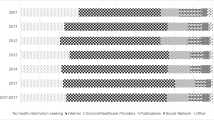Abstract
Utilization of many screening procedures to detect cancer in early stages remains low. In order to design more effective strategies to increase utilization of these tests, we assessed the role and relative importance of different information sources on knowledge and use of cancer screening exams. Where individuals get useful information about disease prevention, and the relationship of information sources to cancer screening knowledge and behavior are reported using data from the 1987 National Health Interview Survey. Results indicate that physicians are perceived as important sources of information on how to prevent illness. However, persons who use print media as their most useful source of information are significantly more likely to have heard of cancer screening procedures than those who rely on the doctor as the source. Those who rely on electronic media tend to be less knowledgeable of all screening procedures examined. A strong and consistent association between doctor as the most useful source of information and actually having received the procedure was found. These results suggest that knowledge may not necessarily be a prerequisite to screening and indicate that reliance on the physician to recommend cancer screening may be critical in utilization of these services.
Similar content being viewed by others
References
National Cancer Institute:Cancer Control Objectives for the Nation: 1985–2000. National Cancer Institute Monographs 2. DHHS Pub. No. (NIH) 86-2880. Bethesda, MD: U.S. Department of Health and Human Services, 1986.
National Cancer Institute, Early Detection Branch, Division of Cancer Prevention and Control:Working Guidelines for Early Cancer Detection. 1987, (UnPub).
Centers for Disease Control, Use of mammography—United States, 1990.MMWR 39:621–630, 1990.
National Cancer Institute:Cancer Statistics Review 1973–1986. DHHS Pub. No. (NIH)89-2789. Bethesda, MD: U.S. Department of Health and Human Services, 1989.
Gallup Organization, Inc: The 1987 survey of public awareness and use of cancer detection tests. Princeton: The Gallup Organization, Inc., 1988.
Lerman C, Rimer B, Engstrom PF, Reducing avoidable mortality through prevention and early detection.Cancer Research 49:4955–4962, 1989.
Brown ML, Potosky AL, Thompson GB, Kessler LG, The knowledge and use of screening tests for colorectal and prostate cancer: data from the 1987 National Health Interview Survey.Prev Med 19:562–574, 1980.
Harlan LC, Berstein AB, Kessler LG, Cervical cancer screening: who is not screened and why?Am J Public Health 81:885–890, 1991.
Dawson DA, Thompson GB: Breast Cancer Risk Factors and Screening: United States, 1987. National Center for Health Statistics.Vital Health Stat 10(172), 1989.
Celentano DD, Klassen AC, Weisman CS, Rosenshein NB, Cervical cancer screening practices among older women: results from the Maryland cervical cancer case-control study.J. Clin Epidemiol 41:531–41, 1988.
Hayward RA, Shapiro MF, Freeman HG, Corey CR, Who gets screened for cervical and breast cancer? Results from a new national survey.Arch Intern Med 148:1177–81, 1988.
Makuc DM, Freid VM, Kleinman JC: National trends in the use of preventive health care by women.Am J Public Health 79:21–6, 1989.
National Cancer Institute Breast Cancer Screening Consortium, Screening mammography: a missed clinical opportunity?JAMA 264:54–58, 1990.
Rimer BK, Keintz MK, Kessler HB, Engstrom PF, Rosan JR, Why women resist screening mammography: patient related barriers.Radiology 172:243–246, 1989.
Woolhandler S, Himmelstein DU, Reverse targeting of preventive care due to lack of health insurance.JAMA 259:2872–4, 1988.
Lerman C, Rimer B, Trock B, Balshem A, Engstrom PF, Factors associated with repeat adherence to breast cancer screening.Prev Med 19:279–290, 1990.
Mamon JA, Shediac MC, Crosby CB, Sanders B, Matanoski GM, Celentano, DD, Inner city women at risk for cervical cancer: behavioral and utilization factors related to inadequate screening.Prev Med 19:363–376, 1990.
Celentano DD, Shapiro S, Weisman CS: Cancer preventive screening behavior among elderly women.Prev Med 11:454–63, 1982.
Bergner M, Allison CJ, Diehr P, Ford LG, Feigl P, Early detection and control of cancer in clinical practice.Arch Intern Med 150:431–436, 1990.
Wilson J, Romano RM, Stein J, Public perception of cancer risk and prevention: implications for physicians.MMJ 34:63–66, 1985.
National Cancer Institute: Technical Report,Cancer Prevention Awareness Survey, Wave II. DHHS Pub. No. (NIH) 97-2907. Bethesda, MD: U.S. Department of Health and Human Services, 1987.
Fruchter RG, Boyce J, Hunt M: Missed opportunities for early diagnosis of cancer of the cervix.Am J Public Health 70:418–20, 1980.
Kleinman JC, Kopstein A, Who is being screened for cervical cancer?Am J Public Health 71:73–6, 1981.
Shah BV, Folsom RE, Harrell FE, Dillard CN:Survey Data Analysis Software for Logistic Regression. Research Triangle Park, NC: Research Triangle Institute, 1984.
Hosmer DW, Lemeshow S:Applied Logistic Regression. New York: Wiley, 1989.
Stone AJ, Siegel JM, Correlates of accurate knowledge of cancer.Health Education Quarterly 13:39–50, 1986.
Iverson D, Vernon DS: Program principles associated with successful health education and health promotion interventions. In: Cummings CC, Floyd JD (Eds.)Human Behavior and Cancer Risk Reduction. Atlanta, GA: American Cancer Society, 1989, Pp. 35–43.
Bettinghaus EP, Health promotion and the knowledge-attitude-behavior continuum.Prev Med 15:475–491, 1986.
Milio N: The effects of policy on choice-making by health care consumers and practitioners. In: Milio N,Promoting Health Through Policy. Philadelphia: F.A. Davis Company, 1981, Pp. 91–113.
Rimer BK, Trock B, Engstrom PF, Lerman C, King E, Why do some women get regular mammograms?Am J Prev Med 7:69–73, 1991.
Author information
Authors and Affiliations
Additional information
Helen I. Meissner is public health advisor, Public Health Applications Research Branch, Arnold L. Potosky is operations research analyst, Applied Research Branch, both at the National Cancer Institute, Bethesda, Maryland. Rena Convissor is associate director, Alcohol Advocacy Resource Center at the Advocacy Institute, Washington, D.C.
Rights and permissions
About this article
Cite this article
Meissner, H.I., Potosky, A.L. & Convissor, R. How sources of health information relate to knowledge and use of cancer screening exams. J Community Health 17, 153–165 (1992). https://doi.org/10.1007/BF01324404
Issue Date:
DOI: https://doi.org/10.1007/BF01324404



